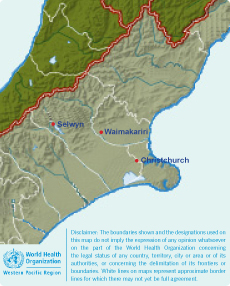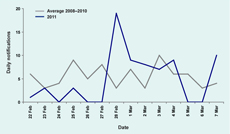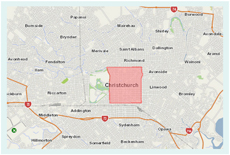“Shake, Rattle and Roll”: risk assessment and management for food safety during two Christchurch earthquakes
Lessons from the Field
Sally Johnstona
a New Zealand Ministry for Primary Industries (e-mail: Sally.Johnston@mpi.govt.nz).
To cite this article:
Johnston S. “Shake, Rattle and Roll”: risk assessment and management for food safety during two Christchurch earthquakes. Western Pacific Surveillance and Response Journal, 2012, 3(2):24-29. doi:10.5365/wpsar.2012.3.2.011
Abstract
Problem: Two earthquakes recently struck the Christchurch region. The 2010 earthquake in Canterbury was strong yet sustained less damage than the 2011 earthquake in Christchurch, which although not as strong, was more damaging and resulted in 185 deaths. Both required activation of a food safety response.
Context: The food safety response for both earthquakes was focused on reducing the risk of gastroenteritis by limiting the use of contaminated water and food, both in households and food businesses. Additional food safety risks were identified in the 2011 Christchurch earthquake due to the use of large-scale catering for rescue workers, volunteers and residents unable to return home.
Action: Using a risk assessment framework, the food safety response involved providing water and food safety advice, issuing a boil water notice for the region and initiating water testing on reticulation systems. Food businesses were contacted to ensure the necessary measures were being taken. Additional action during the 2011 Christchurch earthquake response included making contact with food businesses using checklists and principles developed in the first response and having regular contact with those providing catering for large numbers.
Outcome: In the 2010 earthquake in Canterbury, several cases of gastroenteritis were reported, although most resulted from person-to-person contact rather than contamination of food. There was a small increase in gastroenteritis cases following the 2011 Christchurch earthquake.
Discussion: The food safety response for both earthquakes was successful in meeting the goal of ensuring that foodborne illness did not put additional pressure on hospitals or affect search and rescue efforts.
Christchurch, New Zealand, is now best known to many people for the earthquakes that occurred in September 2010 and February 2011 – the latter killing 185 people. This article outlines some of the lessons learnt from the food safety response for each of the two earthquake events.
The 2010 Canterbury earthquake
Problem
The 2010 Canterbury earthquake was a 7.1 magnitude earthquake that struck at 04:35 on 4 September 2010. While the quake caused widespread damage and several power outages, there were low numbers of serious injuries and no fatalities – probably because the quake occurred during the night when most people were off the street. However, the damage was of such significance that the National Crisis Management Centre1 was activated and Civil Defence personnel in the relevant councils declared local states of emergency for Christchurch, the Selwyn District and the Waimakariri District (Figure 1). Power was disrupted in up to 75% of Christchurch, as well as many towns in the Canterbury region. Sewers were damaged and water lines were broken. A feature of the quake was significant soil liquefaction, which can cause buried pipes to float up to the surface. Some houses were damaged to the point that they were unsafe for residents. Welfare centres were set up in several locations, where more than 244 people slept on the night after the quake.

Figure 1. Districts for which a state of emergency was declared, 2010 Canterbury earthquake
Context
The risk assessment process in the 2010 earthquake response involved a range of food safety experts gathering in Wellington to discuss likely effects of the earthquake for consumers and food businesses. The discussions included identifying regulatory requirements unable to be met in the affected areas and the effects of damage and possible consequences on food safety (risks). Assumptions about levels and effects of damages were tested with field staff in the Canterbury region. Potential risks were prioritized and risk management options identified. Risk assessors and risk managers worked collaboratively in identifying risks, assessing likely impacts and deciding which risk management options to apply.
The primary food safety risks included:
-
The use of contaminated water in food preparation and processing. There was a high likelihood that the earthquake and resulting liquefaction had damaged the water reticulation system through damage to buried pipes, which may have allowed sewage to contaminate the residential water supply.
-
The use of contaminated foods due to property damage, unsafe water supplies and storage outside safe temperatures (due to power cuts).
Action
Water testing for indicators of faecal contamination (e.g. Escherichia coli) on reticulation systems was initiated immediately.
Key actions aimed at the public included:
-
Providing water safety advice regarding water used for drinking and general hygiene (e.g. brushing teeth, handwashing);
-
Issuing a boil water notice for the region; and
-
Issuing food safety advice, including management of food in refrigerators and freezers in areas without power.
The key action aimed at food businesses was:
Having food safety officers and auditors circulate throughout the region to ensure food businesses were taking the necessary measures. This included:
-
Ensuring that such businesses were able to render water for safe use with food. Many of these businesses use substantial amounts of water in processing and were keen to re-open as soon as possible.
-
Conducting assessments for those businesses that had sustained moderate damage to ensure food had not become contaminated with physical hazards and that subsequent manufacturing of food would be protected from contamination by physical, chemical and microbiological hazards.
-
Suspending the issuing of export certificates for export food businesses until adequate food safety measures were implemented and were effective.
Outcome
-
About 90% of the electricity in Christchurch was restored by 18:00 the day of the earthquake. The repair of electricity was more difficult in the rural areas; however power was restored to almost all areas within two days.
-
The boil water notice for Christchurch and Banks Peninsula was lifted late on 8 September 2010 after more than 500 tests conducted over three days found no contamination. A boil water notice for most of Selwyn District was lifted on 9 September. The boil water notice remained in effect for parts of Waimakariri District until 19 September because Escherichia coli was found in a water sample from Kaiapoi (a town in the District).
-
Most food safety officers generally found proprietors making sensible food safety decisions and using good practice around water management and food preparation.
-
Several cases of gastroenteritis were reported. By 7 September, 28 cases had been observed at the city’s welfare centres. Public health officers reported that the majority of these cases resulted from person to person contact rather than contamination of food.
The February 2011 Christchurch earthquake
Problem
The February 2011 Christchurch earthquake, although smaller in magnitude than the 2010 earthquake, was more damaging and deadly for several reasons. The epicentre was closer to Christchurch, and shallower. The earthquake occurred during lunchtime on a weekday when the Central Business District (CBD) was busy and many buildings were already weakened from the previous quake and ongoing aftershocks. Liquefaction was significantly greater than that of the 2010 earthquake, causing significant ground movement, undermining many foundations and destroying infrastructures. Although communication was initially difficult, and it took many hours for a full picture of the devastation to be obtained, a full emergency management structure was in place within two hours, with national coordination again operated from the National Crisis Management Centre. On 23 February, the Minister of Civil Defence declared the situation a state of national emergency, the country’s first for a civil defence emergency.
Context
In this response, risk assessment (using processes as for the 2010 earthquake) identified several risks for food safety and security, including:
-
Water safety – 80% of water and sewerage systems were severely damaged with many reticulation systems failing completely. People relied on alternative water sources such as rainwater, emergency water tanks (untreated water) and swimming pools. Water available via reticulation systems had a high likelihood of water contamination.
-
Poor hygiene and limited access to water due to ignificant damage in several suburbs including inoperable sewerage systems, no power and no or severely restricted road access. Many residents were choosing to remain at home in these suburbs.
-
Food businesses re-opening with limited water availability and non-functioning sewerage systems.
-
Large-scale catering at welfare centres for residents unable or unwilling to return home and at several reporting or gathering sites for rescue workers and volunteers in places that lacked power, water and sewerage systems.
-
Catering at welfare centres being conducted by people not usually involved in the food industry and therefore not aware of food safety requirements.
-
Volunteers within and outside the region were very keen to help with donations of food and other assistance. For example the “Rangiora Earthquake Express” provided water, medical supplies and food, including hot meals, from nearby Rangiora by helicopter and truck.
Action
The key actions for this response were similar to the 2010 earthquake with respect to issuing water and food safety advice, issuing a boil water notice for the region and initiating water testing on reticulation systems. Some changes and additions to this included:
-
Printing flyers with water and food safety advice and distributing these via supermarkets, but as we had learnt from the 2010 earthquake response that many residents were unable to get this advice easily from web sites (due to power outages).
-
Making contact with food businesses using information, checklists and principles developed in the first response.2–6 The approach used by food safety officers was:
-
(a) Advisory – focusing on boil water management for appliances (e.g. ice-machines, slushies, snow freeze, post-mix and coffee machines – all of which needed to be supplied with pre-boiled water if they were going to be used) and general hygiene.
-
(b) Relaxed regulation – sort the operators demonstrating good food safety behaviours (allow them to operate) from those that are trying to make good food safety decisions but need help or advice (provide as needed) from the operators disregarding or not following good food safety practices (revisit often, or as a last resort apply food safety sanctions).
-
Apply a hierarchy of:
(i) Food Security – ensure residents can get enough to eat. This might mean accepting higher than usual food safety risks in some circumstances (within reason, remembering that in this situation food shortages are likely to be very temporary).
(ii) Food Safety – preventing foodborne illness from placing additional pressure on hospitals or affecting search and rescue and earthquake recovery efforts (by taking people out of the workforce).
(iii) Food Suitability – food supplied/donated to the response and recovery efforts should still meet basic requirements for information and labelling (e.g. allergen identification).
(iv) Food Quality – a low priority issue, as consumers will be able to make their own choices about whether to consume these products.
-
Communicating regularly and clearly with stakeholders (public, food businesses, other government agencies, welfare and community organizations); communicating face to face whenever possible and without assuming prior knowledge or understanding.
-
Making decisions quickly when faced with new information or situations – do or delegate (required action), defer (decisions to a higher authority if in doubt), dump (unsafe food).
-
Making contact with welfare, church and community groups to provide food safety advice for catering for large numbers of people.
-
Recommending that professional caterers be used in key areas where mass gatherings were regularly occurring (e.g. welfare centres, worker/volunteer coordination sites), or (as time went on) at funerals.
-
Providing specific advice for donated food.
-
Visiting key community initiatives to support the provision of safe food and ensuring the general food safety steps (clean, cook, cover, chill) were being followed.
-
Printing food safety advice in several languages and deploying a Cantonese/Mandarin-speaking Food Safety Officer to get better compliance with food safety principles where language barriers had been shown to be an issue.
-
Working with the insurance council as food businesses were not disposing of spoilt food because insurance assessments were required and insurance agencies wanted to see the extent of the damage.
Outcome
The national Food Safety response to the earthquake lasted less than three weeks. During this time, all of the approximately 2400 food businesses in Christchurch were visited (except the 500 odd in the red zone – cordoned-off CBD areas [Figure 2]), hundreds of enquiries were answered and plans were made for actions to be undertaken as closed food businesses re-opened. The local council and food safety officers resumed business-as-usual food safety management in the region from Monday 14 March 2011. Specific outcomes included:
Figure 2. Christchurch area map showing approximate red zone area, 2011 Christchurch earthquake*
* Reproduced with permissions from Canterbury Earthquake Recovery Authority.
-
Power was restored to 82% households within five days and to 95% within two weeks. Generators were donated, and telephone companies established emergency communications and free calls.
-
Water was supplied in several ways – a major dairy company provided milk tankers to bring in water, the Army provided desalination plants, and bottled supplies were sent by volunteers and companies. Main water supply was re-established to 70% of households within one week.
-
Over 2000 portable toilets and 5000 chemical toilets from throughout New Zealand and overseas were brought in, and 20 000 more chemical toilets were placed on order from the manufacturers. Households also had to establish emergency latrines.
-
Over 2000 water samples were taken and tested and over 80 Escherichia coli contaminations were identified.
-
The boil water notice remained in effect until 8 April 2011. Chlorination of water was introduced to help ensure that the water remained safe while the water supply infrastructure remained vulnerable and susceptible to new damage (from ongoing aftershocks).
-
Insurance requirements had to be clarified to ensure both food safety and insurance assessment
-
There was a small increase in gastroenteritis cases in the first week following the earthquake (Figure 3); the number of reported cases to 22 March 2011 was 18 more than the average for the same period over the previous three years.

Figure 3. Number of Enteric notifications from 22 February to 7 March, Canterbury, 2011 and 2008–2010 average7
Discussion
Food safety is not always immediately recognized as an important factor in response to natural disasters. People tend to focus initially on treating the injured, looking for survivors and repairing damage (e.g. restoring power, water supplies, opening transport routes). But in the background, food safety professionals are working hard, often from the minute of hearing about a natural disaster, to ensure that, among other things, hospitals are not put under further pressure with increasing numbers of cases of foodborne illness.
There were significant lessons learnt from the food safety response to both earthquakes in Christchurch. The response to the February 2011 Christchurch earthquake was both helped and hindered by the experience of the 2010 Canterbury earthquake. It was helped because all response agencies had learnt valuable lessons from the first event. It was hindered because many Christchurch residents had an expectation that water would be safe (because it had proven safe in the first event). This reinforces the view that while response preparedness is important, it is also important to be flexible and adapt to the specific needs of each response (no matter how similar, no two events are the same).
As there were only small numbers of gastroenteritis cases reported after each earthquake, we consider that the food safety response for both the 2010 Canterbury earthquake and the 2011 Christchurch earthquake was successful in meeting the goal of ensuring that foodborne illness did not put additional pressure on hospitals or affect search and rescue and earthquake recovery efforts.
Conflicts of interest
None declared.
Funding
None.
References:
-
The National Crisis Management Centre. Wellington, Ministry of Civil Defence & Emergency Management, 2012. Available from: http://www.civildefence.govt.nz/
memwebsite.nsf/wpg_url/about-the-ministry-what-we-do-national-crisis-
management-centre?opendocument [accessed 31 May 2012].
-
Food safety guidance for preparing food during emergency situations. New Zealand Ministry for Primary Industries, 2011. Available from: http://www.foodsafety.govt.nz/
elibrary/industry/emergency/food-safety-guidance.pdf [accessed 31 May 2012].
-
Restarting a food business after an emergency – checklist. New Zealand Ministry of Primary Industries, 2011. Available from: http://www.foodsafety.govt.nz/elibrary/
industry/emergency/restarting-a-food-business-after-an-emergency.doc [accessed
31 May 2012).
-
Tips for safe food during/after an emergency. New Zealand Ministry of Primary Industries, 2011. Available from: http://www.foodsafety.govt.nz/elibrary/
industry/emergency/tips-for-safe-food-during-an-emergency.pdf [accessed
31 May 2012].
-
Reopening a food business after an earthquake - Important advice to cafes, restaurants and food retailers. New Zealand Ministry of Primary Industries, 2011. Available from: http://www.foodsafety.govt.nz/elibrary/industry/emergency/
reopening-a-food-business.htm [accessed 31 May 2012].
-
Food safety guidance for preparing food for large groups during emergency situations. New Zealand Ministry of Primary Industries, 2011. Available from: http://www.foodsafety.govt.nz/elibrary/industry/emergency/catering-
for-large-groups.pdf [accessed on 31 May 2012].
-
Dell R, Williams D. Public Health Response to the February 22 Christchurch Earthquake Progress Report. Canterbury District Health Board, Community and
Public Health, 2011. Available from: http://www.cph.co.nz/Files/Feb11EQ-CPH
ResponseReport.pdf [accessed 31 May 2012].



